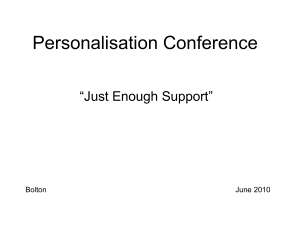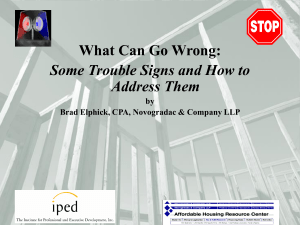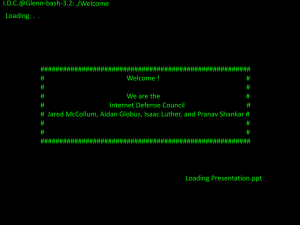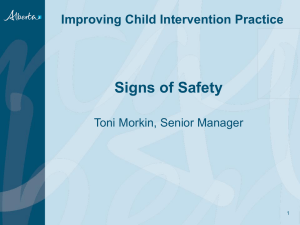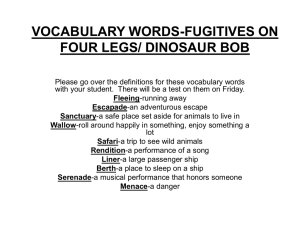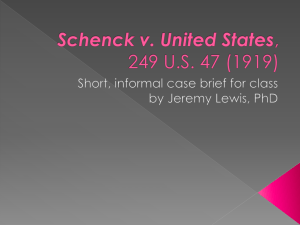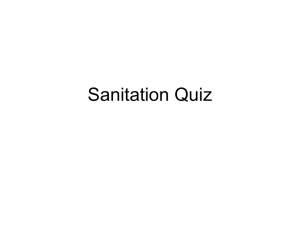Present Danger - Florida`s Center for Child Welfare
advertisement
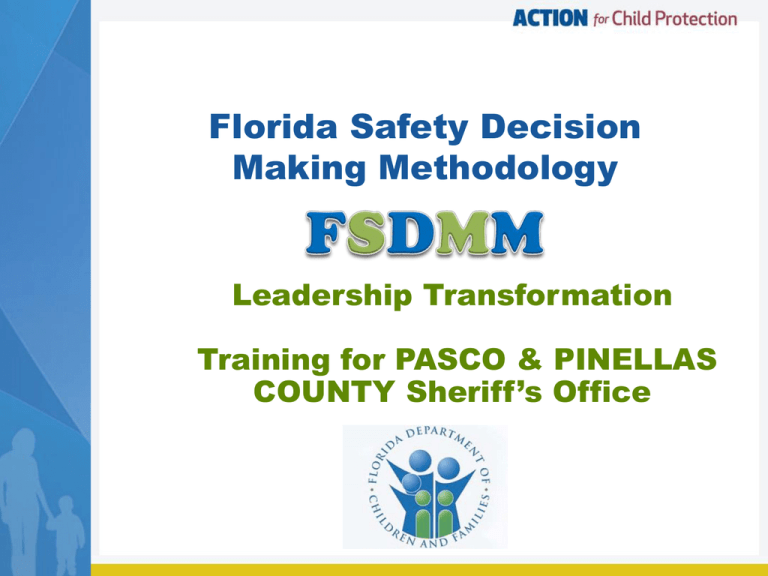
Florida Safety Decision Making Methodology Leadership Transformation Training for PASCO & PINELLAS COUNTY Sheriff’s Office Workshop Introduction • Context for the Training • Background on the Family Functioning Assessment • Training related to Implementation of Florida Safety Decision Making Methodology • Fidelity of the Family Functioning Assessment – Philosophy of practice – Intervention purpose and framework – Conceptual and criteria basis for practice and decision making – Process, practice and outcomes Participant Introductions 1. Name 2. Agency 3. What’s your role with transformation ? 4. What is the one-thing you are looking forward when your agency rolls out this year ? (From what you have heard) Baseline Knowledge Assessment Not a Test Where is Florida now & where do we need to be? “Storming the Castle Theory” How TRANSFORMATION will get us there Safety Intervention: Storming the Castle »Culture of Agency and Staff Perception »Hotline and CPI »Ongoing Case Management »Engagement with Families »Information Collection »Safety Planning »Case Planning Module 2 Florida Safety Decision Making Methodology: Conceptual Framework Module 2 Learning Objectives Participants are able to: • Define the Florida Safety Decision Making Methodology. • Define indicators of success for the Florida Safety Decision Making Methodology • Define the Family Functioning Assessment through describing the intervention purpose and objectives of the Family Functioning Assessment. Session 1 Florida Safety Decision Making Methodology: Safety Intervention Model Session 2 Purpose and Conceptual Framework for Family Functioning Assessment Family Functioning Assessment (FFA - Investigation) Purpose Practice Objectives Identify families in which children are unsafe and in need of full ongoing Case Management protective services (whether non-judicial or judicial/court ordered) Determine children who are unsafe Protect children who are unsafe Establish and manage safety plans Verify the occurrence of maltreatment Identify problems associated with impending danger & caregiver protective capacities May refer families for community based supports (prevention/family preservation/diversion) for children determined to be “safe” Focus of the Family Functioning Assessment Focus – Center of attention of the assessment FFA vs. Incident Focused FFA Incident Focused Effectiveness related to evaluating safety Information collection focused on family functioning Caregiver protectiveness – child needs orientation Maltreatment is symptomatic of problem Concerned with factual information Understanding impending danger and caregiver protectiveness Effectiveness related to reconciling guilt Effectiveness related to proving an allegation of maltreatment. Information collection focused on incident Perpetrator – victim orientation Maltreatment is the problem Concerned with evidence Validating maltreatment Module 3 Essential Skills (FSDMM) and Family Centered Practice Module 3 Learning Objectives Participants will: • Review the core tenets of Florida’s Family Centered Practice Model and understand how the model has been updated to incorporate the Florida SDMM. • Review application of core tenets through case observation. Family Centered Practice • • • • • • • • • Demonstrate respect and courtesy Demonstrate genuineness and equity Respond promptly Continually seek to engage Act and respond with the family as the primary source of information Provide support and encouragement Demonstrate professionalism Enable and promote participation and involvement Provide necessary information Demonstration of Respect & Courtesy • Engagement with family • Demonstrate empathy & engagement by the agency Demonstration of Genuiness & Equity • Engagement with family • Investment in family outcomes • Understanding to seek resolution Responding Promptly • Attention & Engagement with the family • Family feels connected Constantly Seeking to Engage • Without the family, practice cannot proceed. • Information & decision-making will be insufficient. • The family is our customer we should continually seek to engage the family. Act & Respond with the family as the Primary source of Information • Families are the experts on their family. Provide Support & Encouragement • Child welfare is intrusive • Support & encouragement reinforces empathy & understanding by the CPI Demonstrate Professionalism • Explore who we conduct out business • How we present to families? • How we maintain our professional objectivity? Enable and Promote Participation & Involvement • Families participation and involvement is critical. • Change will not happen without it. Provide Necessary Information • Knowledge is power • Keeping families informed Session 2 Essential Skills 5 Essential Skills • • • • Engagement Teaming Safety Assessment Safety Planning and Identification of Family Needs • Safety Management Conclusion of Module 3 Module 4 Pre-Commencement and Commencement: Assessment of Present Danger Module 4 Learning Objectives Participants are able to • Define and discuss pre-commencement activities associated with responding to Hotline Intakes. • Discuss the significance of pre-commencement activities for responding to Hotline Intakes. • Discuss and evaluate supervisory and front line staff pre-commencement activities associated with responding to Hotline Intakes. Session 1 Information Collection Protocol Definition Information Collection Protocol: Pre-Commencement Pre-Commencement Demonstration: Large Group Activity Pre-Commencement Demonstration: Small Group Activity Information Collection Extent of Maltreatment Disciplinary Practices/Behavior Management General Parenting Practices KNOW THE FAMILY Adult Functioning Surrounding Circumstances Child Functioning Information Collection Protocol • Agency policies, intervention standards, procedures, and agreement along with the state of art translated into a uniform and systematic approach that describes how an activity/process will be carried out. Information Collection Protocol: Pre-Commencement Protocol is being incorporated into Florida Administration Code (FAC) 65c-28, 65c-29, 65c-30 Effective July 1, 2013 Pre-Commencement Demonstration What that looks like? Session 2: Present Danger Assessment Child Safety Danger Threats and Definitions Present Danger Impending Danger Conceptual Framework for Present Danger Identifying Present Danger Initial Contact Confirming Present Danger: The Role of the Supervisor Safe • Safe: A child can be considered safe when there is no threat of danger to a child within the family/household or when the caregiver protective capacities within the household can manage threats of danger. • Unsafe: A child is unsafe when there is a danger threat to a child within a family/household and the caregiver protective capacities within the household are insufficient to manage the threat of danger, thus requiring protective intervention (action). Danger Threat: Present Danger • Present danger is an immediate, significant and clearly observable family condition occurring in the present tense, already endangering or threatening to endanger a child. It is important to understand that the primary criterion that qualifies present danger is what is happening that endangers a child is happening now; it is currently in process of actively placing a child in peril. Danger Threat: Impending Danger • Impending danger is associated with a child living or being in a position of continual danger’ Danger may not exist at a particular moment or be an immediate concern, but a state of danger exists. Impending danger is not necessarily active in the sense that a child might be hurt immediately like is true of present danger. When a child lives in impending danger one can expect severe harm as a reasonable eventuality. • Impending danger refers to threats to a child’s safety that exist; are insidious; but are not immediate, obvious, or active at the onset of DCF intervention. • Impending danger refers to threats that eventually are identified and understood upon more fully evaluating and understanding individual and family conditions and functioning. Danger Threat Guide Danger Threat: Assessment of Present Danger Reading and Debrief Conceptual Framework for Present Danger • Present Danger? –If what is being stated is true, does it equate to Present Danger? FFA Intervention Standards: Initial Contact • Diligence in Response • Assessment of Present Danger • Time to Respond – 4 Hours – 24 Hours Identifying Present Danger at Initial Contact Rules to live by Don’t assume parents know what you do. Be able to clearly articulate what your agency does, and be able to describe your purpose. Remain neutral—don’t minimize but don’t feel the need to defend. Don’t make promises. Listen and allow for emotion. Begin engaging the family Avoid (at this point in the interview) getting bogged down by being preoccupied with the specifics of the referral. Elicit help from the parents--they are the authority figures in their home. Initial Contact Consultation: Identifying and Justifying Present Danger • • • • • • • • What is the status of information collection? Who has the CPI/Case Manager interviewed or contacted? Can the CPI/Case Manager clearly describe the conditions that they believe endanger the child? What is the condition of the child and how does the child’s condition fit with the definition of present danger? What is the condition of the caregivers and how does the caregiver condition fit the definition of present danger? Based on what the CPI/Case Manager is describing, does the danger seem currently active, vivid, and reasonable? Is the CPI/Case Manager describing a family circumstance and/or aspect of caregiver functioning that is currently and/or actively threatening child safety? Does the CPI/Case Manager feel compelled to take action immediately to assure the protection of the child? And if so, why? If the CPI/Case Manager were to take no action based on what is being considered during consultation, what can be anticipated to occur with respect to the concerning family conditions and potential effects on the child? Session 3 Present Danger Plan Present Danger Plan Definition An instantaneous (same day), short-term, sufficient strategy that provides a child responsible adult supervision and care to allow for the completion of the family functioning assessment. Purpose To suspend what is going on long enough to support continuing the family functioning assessment. What Present Danger Plans Must Must Do: Immediate • Must be in motion and confirmed before worker (CPI/Case Manager) leaves the home. Short-Term • Must control danger threat from the present until sufficient information can be gathered and analyzed to determine the need for forming an ongoing safety plan. Present Danger Plans Must Be Sufficient Sufficient • Identification of present danger to a child; • Confirmed to manage present danger: description of how the plan will work; • Confirmation of person(s) responsible for protection; trustworthiness, reliability, commitment, availability, alliance to plan; • Willing parents to cooperate with the plan; • Evaluation of home if child is released or placed with other, or if family-made arrangement is opted; • Estimated time frames of plan and oversight. Conclusion Module 4 Module 5 Information Collection and Documentation Module 5 Learning Objectives Participants are able to: • Further define, discuss, and develop the six domains of information collection for staff. • Define and discuss the application of the information collection protocol for information collection. • Evaluate staff interviews, utilizing essential skills associated with the Florida Safety Decision Making Methodology, for information collection through case application. • Analyze, evaluate, and justify determination of sufficiency of information collection and documentation when applied to case application. Session 1 Information Collection: Six Domains Characteristics and Common Errors Influencing Information Collection and Decision Making Family Functioning Assessment Information Standard Determining Information Collection Sufficiency: An Exercise Information Collection Extent of Maltreatment Disciplinary Practices/Behavior Management General Parenting Practices KNOW THE FAMILY Adult Functioning Surrounding Circumstances Child Functioning Family Functioning Information Standard There is hardly anything so necessary as the ability to distinguish between that which is important and that which is not. – William Barclay Information Collection Protocol Reading Information Collection as Competency I know what I must learn about a family. I know what information I must collect on each case I am assigned. I understand the purposes or reason for needing to know this information. I demonstrate the ability to gather the information. I demonstrate the awareness that everything I do before and during information collection influences the quantity and quality of the information I will collect. I can discuss and write about the information I collected logically, succinctly, and in a way that justifies my conclusions Engaging Families: Application of Essential Skills and Field Assessment Documenting Information Collection Session 2 Florida Family Functioning Assessment FFA Documentation Conclusion Module 5 Module 6 Assessment of Impending Danger and Caregiver Protective Capacities Module 6 Learning Objectives Participants are able to: • • • • • • • • Defend and compare the concepts of safe and unsafe. Illustrate and justify the application of the danger threshold. Evaluate family conditions as danger threats utilizing the danger threshold. Assess and justify the identification of danger threats at impending danger through case application. Discuss caregiver protective capacities. Interpret the significance of caregiver protective capacities to inform safety decision making. Illustrate the application of the concept of caregiver protective capacities. Analyze safety decision making utilizing the concepts of danger threats and caregiver protective capacities. Session 1 • Assessment of Impending Danger • Definition of Safety • • • Impending Danger Criteria • Danger Threshold Qualifying the Danger Threshold Criteria • Identifying Family Conditions that meet the Danger Threshold • Impending Danger Threats Safe • Safe: A child can be considered safe when there is no threat of danger to a child within the family/home or when the caregiver protective capacities within the home can manage threats of danger. • Unsafe: A child is unsafe when there is a danger threat to a child within a family/home and the caregiver protective capacities within the home are insufficient to manage the threat of danger, thus requiring outside intervention. Definition of Impending Danger • A state of danger in which family behaviors, attitudes, motives, emotions and/or situations pose a threat which may not be currently active but can be anticipated to have severe effects on a child at any time – Commonly may not be obvious at the onset of CPS intervention or occurring in a present context but can be identified and understood upon more fully evaluating individual and family conditions and functioning. – Child lives in a general state of danger within a family that requires safety intervention to prevent severe harm. How to Judge When a Family Condition is Impending Danger Threshold Criteria: Observable Imminent Out of Control Severity Vulnerable Child Safe Child: Negative Family Conditions are able to be controlled/managed by the family that do not result in unsafe children. Unsafe Child: Negative Family Conditions have crossed the Threshold and are no longer able to be managed/controlled by the Family. Differentiating Family Conditions: Danger Threshold Criteria Observable Out of Control Severe Imminent Vulnerable Child Qualifying the Danger Threshold • • • • • • What Must We Know? How long have family conditions been occurring? (Duration) How often do the family conditions happen? (Consistency) What is the extent of the family conditions? (Pervasiveness) What stimulates/contributes to the family conditions? (Influence) What is the impact on the family? (Impact) How likely is that family conditions will continue? (Continuance) Impending Danger Threats Handout Session 2 Caregiver Protective Capacities Caregiver Protective Capacities Caregiver protective capacities are personal and care giving behavioral, cognitive and emotional characteristics that specifically and directly can be associated with being protective of one’s young. Caregiver protective capacities are personal qualities or characteristics that contribute to vigilant child protection. Caregiver Protective Capacities Reference Handout Behavioral Protective Capacity Specific action, activity, performance that is consistent with and results in parenting and protective vigilance. Cognitive Protective Capacity Specific intellect, knowledge, understanding and perception that results in parenting and protective vigilance Emotional Protective Capacity Specific feelings, attitudes, identification with child and motivation that results in parenting and protective vigilance. Caregiver Protective Capacity Discussion Conclusion Module 6 Module 7 Safety Planning: Impending Danger Module 7 Learning Objectives Participants are able to: • Discuss the purpose of a safety plan in response to impending danger. • Justify the concepts of safety planning and treatment services. • Justify the need for a safety plan in response to impending danger through the use of the safety planning analysis. • Evaluate case information to justify the development of a safety plan to control for impending danger. Session 1 Plans That Form Intervention Safety Plan Safety Plan vs Treatment/Case Plan What is a Safety Plan? Criteria for a Safety Plan Definition of In-Home Safety Actions Actions Within Safety Plans Scope of a Safety Plan Responsibility for Safety Management and Sufficient Safety Planning Controlling for Danger What and When Present Danger Plan Safety Plan Initial Contacts Conclusion of Family Functioning Assessment Why Control safety Control safety What Present danger Impending Danger Purpose Manage Present Danger while completing the Family Functioning Assessment Manage Impending Danger while allowing case management services to occur When First Contacts Conclusion of Family Functioning Assessment Why Control safety Control safety What Present Danger Impending Danger Purpose Manage Present Danger while completing the information collection and Family Functioning Assessment process Manage Impending Danger while allowing safety management and full case management services to occur Requires safety management and vigilant monitoring Requires: Safety management and vigilant monitoring Case management and case planning Ultimate Responsibility for Safety Management: AGENCY Safety Plan: Same Template; Different Purpose Safety Plan vs Case Plan Safety Plan Case Plan Why Control safety Treatment What Danger Caregiver Protective Capacities Purpose at conclusion of FFA process Manage Impending Danger while allowing case management services to occur Enhance Caregiver Protective Capacities Creating a Strategy for Maintaining Child Care: The Scenario • It has been determined by your doctor that due to the severity of a recent medical condition it is going to be perhaps several months until you are feeling up to par. Due to this illness, you are generally unable to consistently attend to primary and essential parenting responsibilities on your own. (i.e., feeding, bathing, dressing, supervision, structure, etc.) What is a Safety Plan? • A written arrangement between caregivers and the agency that establishes how impending danger threats to child safety will be managed • Must be implemented and active as long as threats to child safety exist and caregiver protective capacities are insufficient to assure a child is protected What are the criteria for Safety Plans? • Must control or manage Impending danger. • Must have an immediate effect. • Must be immediately accessible and available. • Must contain safety services and actions only. • No promissory commitments. Definition of In-Home Safety Actions: Taking Control of an Out-of-Control Family Condition • Active and intentional efforts made by DCF (CPI or Case Manager), the family, informal and formal resources that will assume the responsibility for assuring that a child’s basic needs and safety needs are met. Actions within Safety Plans • Safety Categories: – Behavioral Management – Crisis Management – Social Connection – Resource Support – Separation What is the Scope of Safety Plans? • Use of in-home, out-of-home, combination of actions. • Clarification of the role of parents (caregivers) in the plan. • Protective role of others. • Specification of the safety services from a limited to extensive perspective. • Use and responsibility of the family network and professionals. • Parent (caregiver) access to child. • Identification and rationale for different kinds of separation. • Anticipated time limits that govern separation. Developing Sufficient Safety Plans Once threats to child are identified, the responsibility for assuring safety management rests with DCF! When is a Safety Plan Sufficient? A safety plan is sufficient when it is a well thought-out approach containing the most suitable people taking the necessary actions, frequently enough to control danger threats and/or substitute for diminished caregiver protective capacities. Purpose for Safety Planning Analysis • Analyze the relationship between specific pieces of information for determining the degree of intrusiveness and the level of effort necessary for assuring that a DCF safety plan will be reasonably effective in protecting a child. Safety Analysis Questions Safety Analysis Question #1 •The parents/legal guardians are willing for an in-home safety plan to be developed and implemented and have demonstrated that they will cooperate with all identified safety service providers. Safety Analysis Question #2 •The home environment is calm and consistent enough for an in-home safety plan to be implemented and for safety service providers to be in the home safely. Safety Analysis Question #3 •Safety services are available at a sufficient level and to the degree necessary in order to engage the way in which impending danger is manifested in the home. Safety Analysis Question 4 •An in-home safety plan and the use of in-home safety services can sufficiently manage impending danger without the results of scheduled professional evaluations. Safety Analysis Question 5 •The parents/legal guardians have a residence in which to implement an in-home safety plan. Safety Planning Determination Meeting: Focus Points • Focus on how to manage the safety factors— know and understand. • Identify action areas that match up with danger threats. • Consider actions/services within action areas that seem relevant. • Apply the 4 – Ws and the Big H. • Based on the group analysis, judge sufficiency. • Complete the safety plan. • Be prepared to explain and justify your safety plan. Developing the Safety Plan Case Application Florida Case Review Small Group Exercise Conclusion Module 7 Module 8 Completing the Investigation Module 8 Learning Objectives • Participants are able to: • Apply the Child Maltreatment Index for Maltreatment Finding • Define and illustrate the purpose of the risk assessment for investigation completion. • Evaluate the application of the risk assessment through case application. • Evaluate the investigation closure for appropriateness. • Assess the actions necessary for case transfer to community based care and ongoing safety management. Session 1 Maltreatment Finding Definition of Maltreatment “Maltreatment” means a specific type of injury or harm Determining the Finding Finding: • The determination as to whether there is a preponderance of credible evidence supporting the reported harm or threat of harm for each alleged maltreatment. • • • VERIFIED. This finding is used when a preponderance of the credible evidence results in a determination that the specific harm or threat of harm was the result of abuse, abandonment or neglect by a parent or caregiver. NOT SUBSTANTIATED. This finding is used when there is not a preponderance of credible evidence to support that the specific harm or threat of harm was the result of abuse, abandonment, or neglect by a parent or caregiver. NO INDICATORS. This finding is used when there is no credible evidence to support the allegations of abuse, abandonment, or neglect by a parent or caregiver. Risk Assessment Safe Children: • provides a measure for identifying families for prevention services. Unsafe children: • Risk assessment does not determine families for case management services, regardless of risk level. Session 2 Case Transfer Case Transfer Sufficiency Checklist to Guide Transfer Process Case Transfer Meeting Purpose and Outcomes Conclusion Module 8 Training Conclusion POST ASSESSMENT Thank you & Have an Inspirational Day!

